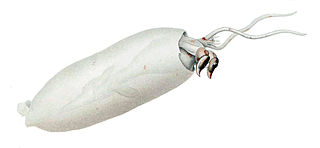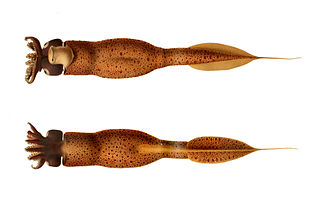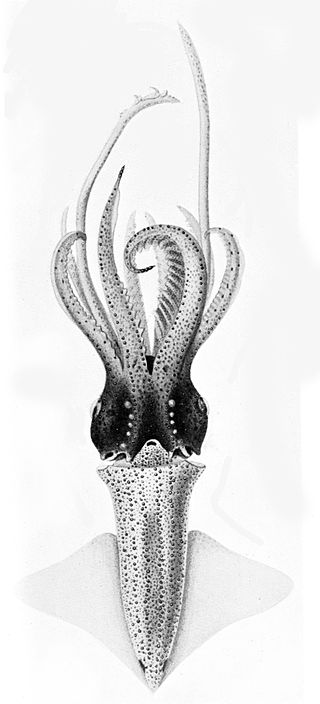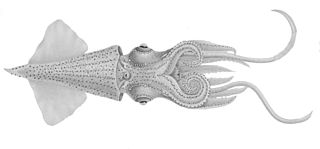
Ancistrocheirus lesueurii, the sharpear enope squid, is the only species in the genus Ancistrocheirus and family Ancistrocheiridae. With a mantle length of 25 cm, this moderately sized squid may be found throughout the tropical and subtropical oceans. They tend to be found at mesopelagic depths.

The Enoploteuthidea are a family of squid comprising approximately 40 species in four genera. Most species have a mantle length ranging from 3–13 cm. Hooks are present on all arms and tentacles. The family is best known for the large array of photophores throughout the body.

The Mastigoteuthidae, also known as whip-lash squid, are a family of small deep-sea squid. Approximately 20 known species in six genera are represented, with members found in both the mesopelagic and bathypelagic zone of most oceans. Originally described by Verill in 1881, it was later lowered by Chun (1920) to a subfamily (Mastigoteuthinae) of the Chiroteuthidae. However, Roper et al. (1969) raised it back to the family level, and this has not been changed since. The taxonomy of this family is extremely unstable, and there have been at times one genus, two genera and four subgenera(Salcedo-Vargas & Okutani, 1994), two genera and several 'groups', five genera and one species with an uncertain placement, or six genera.

The hooked squid, family Onychoteuthidae, currently comprise about 20–25 species, in six or seven genera. They range in mature mantle length from 7 cm to a suggested length of 2 m for the largest member, Onykia robusta. The family is characterised by the presence of hooks only on the tentacular clubs, a simple, straight, funnel–mantle locking apparatus, and a 'step' inside the jaw angle of the lower beak. With the exception of the Arctic Ocean, the family is found worldwide.

Taoniinae is a subfamily containing ten genera of glass squids.

Taonius is a small genus of glass squid. Although it comprises only three recognised species, it has been suggested there may be as many as five species. Taonius borealis is found in the North Pacific Ocean and Taonius pavo is found in the Atlantic and possibly SW Indian Ocean.

Taningia danae, the Dana octopus squid, is a species of squid in the family Octopoteuthidae. It is one of the largest known squid species, reaching a mantle length of 1.7 m (5.6 ft) and total length of 2.3 m (7.5 ft). The largest known specimen, a mature female, weighed 161.4 kg (356 lb).

Euprymna is a genus of bobtail squid comprising a number of species.

Graneledone is a genus of octopuses in the family Octopodidae. The type species is Eledone verrucosaVerrill, 1881.

Abraliopsis is a genus of squid in the family Enoploteuthidae comprising 11 nominal species. Species are characterised by the presence of photophores on arm pair IV. Suckers are absent from this arm. The type species is Abraliopsis hoylei.

Enoploteuthis is a genus of squid in the family Enoploteuthidae. The species of Enoploteuthisare most easily recognised by having a larger tail when compared to the other genera in the Enoploteuthidae. The tail's size is emphasised not having the fins extending along its sides. In related genera there is a narrow extension of the fins along the tail. Other characteristics include the presence of suckers on the distal portion of arms IV where there at no photophores present; the tentacular club has two rows of hooks and no marginal suckers; on the buccal crown there are typical chromatophores on the aboral surface but on the oral surface there may be some light skin pigmentation. They have 9-10 photophores on the eye and they have complex photophores in the skin. In the females the Spermatangia receptacles are at the posterior junction of muscles used to retract the funnel and the muscles which retract the head. Enoploteuthis differs from other genera of the Enoploteuthidae in having two rather than three types of photophores in its integument and these are on the ventral areas of the head, funnel and mantle. All species of Enoploteuthis which have been studied have the most complex type of photophoreand seems to be a distinctive characteristic of this genus. Enoploteuthis contains the largest species in the family, attaining a mantle length of 130mm.

Abraliopsis morisii is a species of bioluminescent squid in the family Enoploteuthidae. The species occurs in tropical to warm temperate waters in the Atlantic Ocean, including the Gulf of Mexico and the Mediterranean Sea. It can be found in the epipelagic and mesopelagic zones. Jean Baptiste Vérany described the species in 1839 and it reaches lengths of 25 to 33 millimetres. It is rated as least concern by the International Union for Conservation of Nature (IUCN).

Teuthowenia megalops, sometimes known as the Atlantic cranch squid, is a species of glass squid from the subarctic and temperate waters of the northern Atlantic Ocean. They are moderately sized squid with a maximum mantle length of 40 cm (16 in). Their very large eyes are the source for the specific name megalops. Like other members of the genus Teuthowenia, they are easily recognizable by the presence of three bioluminescent organs (photophores) on their eyeballs.
Abralia omiae is a species of enoploteuthid cephalopod known only from its type locality, the Dimitry Mendeleyev seamount in the Pacific tropics. A. omiae is a small species, less than 3 cm in mantle length.

Uroteuthis is a genus of 14 species of common inshore squids of the Indo-West Pacific and is further subdivided into 3 subgenera. The members of the genus Uroteuthis are the only squids of the family Loliginidae that possess photophores and all species in the genus have a pair of photophore organs on the ventral surface of their ink sac either side of their intestine.

Doryteuthis is a genus of squid from the waters of the western Atlantic and eastern Pacific off the coast of the Americas species are the common inshore squids of American waters. Some species are important quarry species for fisheries.
Loliolus is a genus of squid from the family Loliginidae from the Indo-Pacific region. The genus is divided into two subgenera Loliolus and Nipponololigo. They are small squids of less than 150mm in mantle length which have an expanded tentacular club. This club has 4 series of suckers. The sucker rings have plate-like teeth which are square in shape all around them. The males' hectocotylus has a ventral crest which is created by the fusion of the protective membrane with the ventral series of papillae and this crest completely obscures the conical shape of the papillae. The mantle is rounded posteriorly and lacks the posterior tail-like lobe while the fins are positioned on the rear of the mantle and extend to the posterior tip of the mantle. Their eggs are small and the males' spermatophore has a short cement body. They do not possess photophores. The two subgenera are distinguished by the hectocotylus which in Loliolus encompasses the entire arm and there are no unmodified suckers while in Nipponololigo the arm is only partly hectocotylsed and has normal suckers at its base.

Enoploteuthis leptura, the hooked enope squid, is a species of squid from the family Enoploteuthidae. It is the type species of the genus Enoploteuthis, which is in turn the type genus of the Enoploteuthidae.

Gonatopsis borealis, the Boreopacific armhook squid, is a species of squid from the North Pacific Ocean. It is a member of the family Gonatidae. It is an abundant species which is currently caught mainly as a bycatch by fishing boats targeting other quarry. It is an important prey species for many commercially important species of fish, as well as for marine mammals.
Lampadioteuthis megaleia is a small, colorful squid, the only species in the only genus in the monotypic family Lampadioteuthidae. It is sometimes known as the wonderful firefly squid. It was formerly classified in the family Lycoteuthidae, but differs from them mainly by having a hectocotylus in the males and by the possession of a rostrum on the gladius.

















